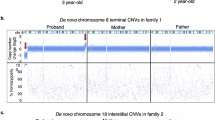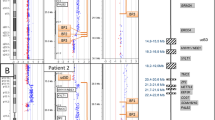Abstract
We report on the effectiveness of a custom-designed oligonucleotide-based comparative genomic hybridization microarray (array-CGH) to interrogate copy number across the entire 2.2-Mb genomic region of the DMD gene and its applicability in diagnosis. The high-resolution array-CGH, we developed, successfully detected a series of 42 previously characterized large rearrangements of various size, localization and type (simple or complex deletions, duplications, triplications) and known intronic CNVs/Indels. Moreover, the technique succeeded in identifying a small duplication of only 191 bp in one patient previously negative for DMD mutation. Accurate intronic breakpoints localization by the technique enabled subsequent junction fragments identification by sequencing in 86% of cases (all deletion cases and 62.5% of duplication cases). Sequence examination of the junctions supports a role of microhomology-mediated processes in the occurrence of DMD large rearrangements. In addition, the precise knowledge of the sequence context at the breakpoints and analysis of the resulting consequences on maturation of pre-mRNA contribute to elucidating the cause of discrepancies in phenotype/genotype correlations in some patients. Thereby, the array-CGH proved to be a highly efficient and reliable diagnostic tool, and the new data it provides will have many potential implications in both, clinics and research.
Similar content being viewed by others
Log in or create a free account to read this content
Gain free access to this article, as well as selected content from this journal and more on nature.com
or
References
Tuffery-Giraud S, Beroud C, Leturcq F et al Genotype-phenotype analysis in 2,405 patients with a dystrophinopathy using the UMD-DMD database: a model of nationwide knowledgebase. Hum Mutat 2009; 30: 934–945.
Abbs S, Tuffery-Giraud S, Bakker E, Ferlini A, Sejersen T, Mueller CR : Best practice guidelines on molecular diagnostics in Duchenne/Becker muscular dystrophies. Neuromuscul Disord 2010; 20: 422–427.
Faivre L, Khau Van Kien P, Callier P et al De novo 15q21.1q21.2 deletion identified through FBN1 MLPA and refined by 244K array-CGH in a female teenager with incomplete Marfan syndrome. Eur J Med Genet 2010; 53: 208–212.
Wildeman M, van Ophuizen E, den Dunnen JT, Taschner PE : Improving sequence variant descriptions in mutation databases and literature using the Mutalyzer sequence variation nomenclature checker. Hum Mutat 2008; 29: 6–13.
Mitsui J, Takahashi Y, Goto J et al Mechanisms of genomic instabilities underlying two common fragile-site-associated loci, PARK2 and DMD, in germ cell and cancer cell lines. Am J Hum Genet 2010; 87: 75–89.
Oshima J, Magner DB, Lee JA et al Regional genomic instability predisposes to complex dystrophin gene rearrangements. Hum Genet 2009; 126: 411–423.
Toffolatti L, Cardazzo B, Nobile C et al Investigating the mechanism of chromosomal deletion: characterization of 39 deletion breakpoints in introns 47 and 48 of the human dystrophin gene. Genomics 2002; 80: 523–530.
Chen JM, Cooper DN, Ferec C, Kehrer-Sawatzki H, Patrinos GP : Genomic rearrangements in inherited disease and cancer. Semin Cancer Biol 2010; 20: 222–233.
Belancio VP, Deininger PL, Roy-Engel AM : LINE dancing in the human genome: transposable elements and disease. Genome Med 2009; 1: 97.
Bovolenta M, Neri M, Fini S et al A novel custom high density-comparative genomic hybridization array detects common rearrangements as well as deep intronic mutations in dystrophinopathies. BMC Genomics 2008; 9: 572.
del Gaudio D, Yang Y, Boggs BA et al Molecular diagnosis of Duchenne/Becker muscular dystrophy: enhanced detection of dystrophin gene rearrangements by oligonucleotide array-comparative genomic hybridization. Hum Mutat 2008; 29: 1100–1107.
Hegde MR, Chin EL, Mulle JG, Okou DT, Warren ST, Zwick ME : Microarray-based mutation detection in the dystrophin gene. Hum Mutat 2008; 29: 1091–1099.
Saillour Y, Cossee M, Leturcq F et al Detection of exonic copy-number changes using a highly efficient oligonucleotide-based comparative genomic hybridization-array method. Hum Mutat 2008; 29: 1083–1090.
Tuffery-Giraud S, Saquet C, Chambert S et al The role of muscle biopsy in analysis of the dystrophin gene in Duchenne muscular dystrophy: experience of a national referral centre. Neuromuscul Disord 2004; 14: 650–658.
Rivier F, Tuffery S, Jellali AJ, Echenne B, Mornet D, Pons F : Mosaic expression of two dystrophins in a boy with progressive muscular dystrophy. Muscle Nerve 1998; 21: 1317–1320.
Desmet FO, Hamroun D, Lalande M, Collod-Beroud G, Claustres M, Beroud C : Human Splicing Finder: an online bioinformatics tool to predict splicing signals. Nucleic Acids Res 2009; 37: e67.
Acknowledgements
This work was supported by an Association Française contre les Myopathies (AFM), grant (AFM-14178 and AFM-15258) to AI. We thank all the physicians, in particular Pr P Sarda, Dr U Walther-Louvier, Dr E Campana Salort, Dr R Bernard, Dr L Lazaro, Dr S Mercier, Dr M Cossée, Dr A David, Pr B Leheup, Dr X Ferrer, Pr PS Jouk, Pr Ph Labrune for providing clinical information and patient material. We are grateful to Céline Saquet and Sylvie Chambert for DNA and RNA analyses in some of the patients, and Nicolas Gilbert for helpful discussion about repetitive elements.
Author information
Authors and Affiliations
Corresponding authors
Ethics declarations
Competing interests
The authors declare no conflict of interest.
Additional information
Supplementary Information accompanies the paper on European Journal of Human Genetics website
Supplementary information
Rights and permissions
About this article
Cite this article
Ishmukhametova, A., Van Kien, P., Méchin, D. et al. Comprehensive oligonucleotide array-comparative genomic hybridization analysis: new insights into the molecular pathology of the DMD gene. Eur J Hum Genet 20, 1096–1100 (2012). https://doi.org/10.1038/ejhg.2012.51
Received:
Revised:
Accepted:
Published:
Issue date:
DOI: https://doi.org/10.1038/ejhg.2012.51
Keywords
This article is cited by
-
Identification and characterization of two DMD pedigrees with large inversion mutations based on a long-read sequencing pipeline
European Journal of Human Genetics (2023)
-
Identification of a novel DMD duplication identified by a combination of MLPA and targeted exome sequencing
Molecular Cytogenetics (2017)
-
Precise mapping of 17 deletion breakpoints within the central hotspot deletion region (introns 50 and 51) of the DMD gene
Journal of Human Genetics (2017)
-
Normal and altered pre-mRNA processing in the DMD gene
Human Genetics (2017)
-
Custom oligonucleotide array-based CGH: a reliable diagnostic tool for detection of exonic copy-number changes in multiple targeted genes
European Journal of Human Genetics (2013)



